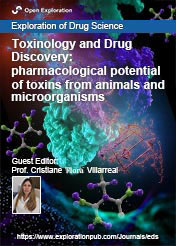-
 Special Issue Topic
Special Issue TopicToxinology and Drug Discovery: pharmacological potential of toxins from animals and microorganisms
Submission Deadline: December 31, 2024Guest Editor
Prof. Cristiane Flora Villarreal E-Mail
Professor, School of Pharmacy, Federal University of Bahia, Salvador, Brazil
Research Keywords: pharmacology of natural products; chronic pain, analgesics, anti-inflammatories; stem cell therapy; mesenchymal cells; cell-free therapy
About the Special Issue
The biosynthesis of toxins is an evolutionary strategy adopted by several living organisms, including animals, bacteria, and fungi. Poisons and venoms play an important role in ecological interactions where they are used as true chemical weapons for both defense and predation. These complex mixtures are rich sources of bioactive molecules, such as proteins, peptides and neurotransmitters whose unique pharmacological properties can be applied in the development of products to improve human health. Toxin-based compounds play a relevant role in the drug discovery process. They can be used as pharmacological tools for identifying new therapeutic targets or studying the mechanism of action of other drugs. Moreover, some toxins have the potential to be used as therapeutic agents or serve as prototypes for drug design.
Historically, toxins from animal venoms have contributed significantly to the discovery of new drugs, as illustrated by captopril, the first animal toxin-based drug approved for human use. Captopril was synthetized based on a peptide present in a viper snake venom and was the hallmark in the development of angiotensin-converting enzyme (ACE) inhibitors, considered a pillar class of antihypertensive drugs in modern pharmacotherapy of arterial hypertension and heart failure. Since the approval of ACE inhibitors in the 1980s, other toxin-based drugs have been developed and made available on the market with therapeutic uses such as antiplatelet, anticoagulant, antidiabetic, and analgesic. Microorganisms are also valuable sources of molecules of pharmacological interest. As an example, botulinum toxin produced by Clostridium botulinum is a potent neurotoxin widely used for both cosmetic and therapeutic purposes. Despite the enormous potential of venoms and toxins for the drug discovery process, the availability of toxin-based drugs on the market is still discreet, pointing to a demand for further studies, investment, and scientific discussion in this research field.
The Special Issue "Toxinology and Drug Discovery: pharmacological potential of toxins from animals and microorganisms" invites researchers to contribute with original research articles and review articles related to all the aspects of development of therapeutic products based on toxins from animals and microorganisms. The aim of this project is to bring together international experts to provide a comprehensive overview of the contribution of toxinology to drug development. We encourage the submission of articles focused on any aspects of the subject, including studies of drug discovery in early stages, as the identification of new toxins, in vitro and in vivo pharmacological and toxicological studies; toxins as pharmacological tools; pharmacokinetic studies; pharmaceutical technology studies; and clinical trials.
Keywords: poisons and venoms; drug discovery; toxins; pharmacology; toxinology
Call for Papers
Published Articles
-
-
Ongoing Special Issues